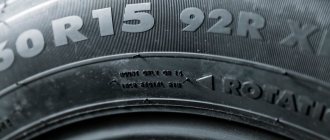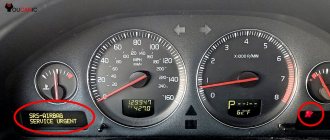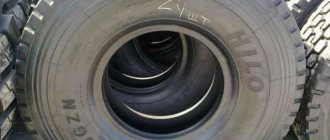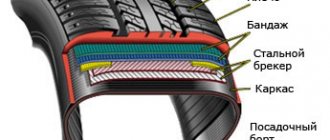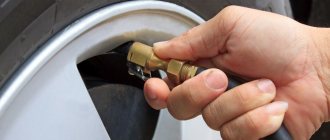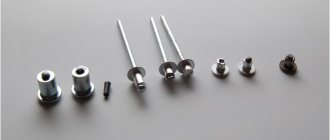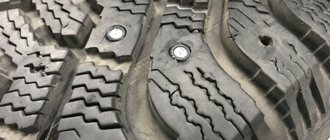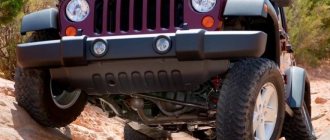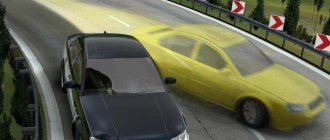Operating a car without wheels is impossible. Previously, almost all tires were tube tires. Then their tubeless counterparts began to actively push them out of their positions.
Currently, tubeless tires account for over 80% of the total market. Chamber ones also remain on sale, but demand for them is gradually falling. This is especially true for passenger cars.
But now there is reason to talk about a completely different direction. These are airless wheels. Not everyone fully understands what they are, where they came from and where they can be used. This needs to be dealt with.
What it is
In many ways, the name airless tires itself reflects the essence of these wheels. This is a special development aimed at solving the main problems of current tires:
- reduction of pressure inside the wheel;
- rapid wear;
- disc deformation.
The idea behind the development is to eliminate the use of air in car tires. That is, no compressors, failed spools and nipples no longer play a role.
But for certain reasons, this innovation has not yet become widespread.
To get better acquainted with airless tires, you should take a short excursion into history, look at the design and scope of these wheels.
Tire strength index
Tire manufacturers assign a ply rating to each tire. This standard does not directly refer to the number of layers in the tire, but is an index of the tire's strength.
Wire winding is made rigid by rubber binding all the wire together, creating a strong connection. The bead wire (bead core) is also strengthened by wrapping fabric strips before applying the main and filler tapes. The main belts, made of rubber and located under the rubberized fabric filler belts, provide greater rigidity and less abrupt changes in the bead section. They also increase the contact area.
Under severe braking conditions, the heating of the wheel, tire, and brake may be sufficient to cause the tire to burst, with potentially catastrophic consequences for the aircraft. To prevent sudden bursting, some tubeless wheels are equipped with thermal sensors. These plugs are installed in the wheel drum using a low-melting alloy, which melts under overheating conditions and is pushed out by the increased air pressure in the tire. This prevents tire pressure from becoming excessively high by reducing tire pressure in a controlled manner.
A feature of airplane wheels, like everything related to aviation, is the constant monitoring of technical condition, so the tire pressure is checked every time after landing and before takeoff.
But landings and takeoffs negatively affect the condition of the tires, so aircraft wheels, unlike automobile wheels, have a relatively short shelf life, and at the slightest suspicion of mechanics they must be replaced.
Excursion into history
Tires without air originate in the Pentagon, the main US military department. You understand that they started talking about them with the aim of introducing them into military equipment. After all, the possibility of a flat tire potentially jeopardizes military operations. And since the United States spends a lot of money on the military industry, it is not surprising that the first projects and proposals for the sale of such tires soon appeared.
For the first time, new generation tires deprived of air were installed on American military Humvees. And it immediately became obvious that the technology works, and it has a number of advantages. But there is also a list of shortcomings.
By tradition, military developments gradually migrated to civilian production.
To what extent these are the wheels of the future is difficult to say. Giving up air potentially opens up impressive prospects. But it’s too early to talk about global implementation of the technology.
Design Features
Now we should take a closer look at what airless rubber is and how it works.
In fact, it is a hollow wheel, inside of which there are mainly rubber walls. They perform the functions of air.
It is the strong and elastic walls that create the desired effect for the wheel, which does not require air to operate. Inside there is a frame, which consists of many rubber-based plates. The plates have a cell structure. There are other development options. A central rubber base is used here, and polyurethane spokes are distributed in different directions from it. Overcoming an obstacle, the tire is deformed and then returns to its original state.
The special airless tire used on cars comes in two types.
- Closed. Externally, it is no different from ordinary car tires. Only special filling is used inside. It's mostly fiberglass.
- Open. This type of tire has a base that is mounted on an axle and a tension clamp. The latter runs along the top and has increased resistance to deformation. Consists of cells or spokes.
If we talk about passenger cars, tires based on rubber spokes are considered a more rational and convenient solution for them.
This is explained by the fact that the manufacturer has the opportunity to change the lateral stiffness, based on the conditions in which the machine is planned to be used and under what loads.
Tires without air - a new product on the automotive market
04/14/2016 The developers of many famous tire manufacturing companies have been trying to surprise their customers with innovations for several years, and they are succeeding quite well.
So, quite recently the world learned about unique tires without air. Today this is no longer a myth, but a reality, and tires of this type provide the car with many advantages. The creators of airless tires combine good handling with smooth maneuvers. Tires easily move over fallen trees, stumps and other obstacles. What is a tire without air, and why is it unusual? Let's try to understand this issue. The creators of airless tires are specialists from the American company Resilient Technologies, which began development back in 2002. To prevent soldiers from exposing their lives to danger in hot spots due to a broken tire, this unique design was invented. The tires have undergone serious tests and tests that have exceeded all expectations.
The airless tire consists of a special structural mesh, which is flexible and durable, which guarantees safety. Two rows of curved thermoplastic rubber spokes are attached to the hub, overlapping each other, with the outer spokes curved in the opposite direction to the inner ones, which provides good shock absorption.
Despite the simple appearance of the tire, its creators put a lot of effort into lengthy calculations, as a result of which the tire has structural integrity, which gives it an incredible ability to easily absorb all impacts and damage.
In 2007, designers developed a prototype of a non-pneumatic tire, the frame of which is made of fire-resistant rubber, shaped like a “honeycomb,” and a rubber rim with tread. This made it possible to achieve additional rigidity equally, and the wheel holds heavy vehicles, accurately performing its functions, even if up to 30% of the honeycombs are destroyed, and softness, since the honeycombs can easily deform, which allows you to feel all the imperfections and uneven roads.
Engineers from the famous French company Michelin worked for a long time to create a tire that could combine optimal rigidity and softness, and so that the vertically directed rubber was soft, pliable, provided shock absorption and comfort of movement, and the transverse direction was rigid and did not deform from lateral loads when turns.
In the end, they decided to abandon the pneumatic tire, and invented a design consisting of flat rubber spokes with a special cross-section, which successfully replaces air-filled tires. The spokes connect the tread, the outer and inner rim, which is attached to the hub. This is how Tweel appeared, which means tire and wheel.
Rubber spokes respond better to impacts and damage, as they tend to bend freely over their entire height, and due to the free cross-section of the spokes during lateral loads, the wheel is not subject to deformation, since the spokes bend only in one plane. Therefore, the lateral stiffness of a tire can be compared to a solid tire, and the energy capacity of a wheel that can absorb impacts depends on the stiffness of the spokes.
This is not the only advantage of Tweel, since the mass of the prototype Michelin tire was several times less than a conventional wheel on a metal rim. Here you can add puncture resistance and increased service life.
Michelin has tested wheels not only on cars, but also on other wheeled structures, such as the iBot robotic wheelchair and the Segway Centaur. The company has currently entered into a contract with NASA, which is ready to use newly developed wheels for lunar rovers.
Application area
Surely airless tires will be a great success and widespread. But not now. The technology is quite crude and has many shortcomings that need to be eliminated in order to be able to implement such solutions globally in the automotive industry.
If we talk about the use of airless tires, then the main emphasis here should be on military equipment. Some cars are even actively used, and are not just exhibition samples.
As for civilian transport, it is not yet possible to install such tires on your car.
There are several areas and modes of transport in which airless tires are already being installed quite successfully:
- lightly loaded vehicles;
- lawnmowers;
- scooters;
- mopeds;
- golf carts;
- excavators;
- loaders;
- bicycles;
- scooters;
- wheelchairs.
Not bad for a technology that is in its early stages of development. If developers continue to work on airless tires, try to eliminate weaknesses and increase the significance of advantages, there is every chance of seeing similar solutions on regular passenger cars. Moreover, we are not talking about single copies, but about the mass introduction of new generation tires.
But it’s objectively too early to talk about something like that. Development for the future. But to what extent it will justify itself and be implemented is an open question.
Main advantages
Speaking of advantages, wheels without air are naturally compared with classic pneumatic tires.
Special tests made it possible to learn about the benefits. Airless airless systems were installed on ordinary civilian cars such as the Audi A4. During the test, it was immediately possible to notice that the car’s handling improved in comparison with similar races, but with air wheels.
There are several main advantages that characterize the strengths of such developments and potentially allow us to count on the gradual introduction of airless tires into the automotive industry.
- Long service life of tires. Tests clearly show that while maintaining 70% of the polyurethane structure, the car will drive without any problems, maintaining the same stability as with 100% integrity of the material.
- There is no need to control pressure here. That is, airless wheels completely eliminate the problem of a punctured wheel or a deflated tire. Even under strong mechanical stress, rubber cannot burst due to its design.
- Reduced weight. The design also reduces the overall weight of the tires. This makes it easier to replace if the need arises.
- Reduced fuel consumption. Another strength follows from the previous advantage. On airless tires, a car requires less fuel than when covering the same distance on air tires.
- Refusal of air allows you to simplify and improve the passage of uneven surfaces and overcoming serious obstacles. The tire simply follows the shape of the bump, and then quickly recovers after driving onto a flat area. At the same time, the passage of such roads is minimally felt in the cabin.
- The likelihood of a wheel rim becoming deformed when driving off-road is reduced to almost zero, which cannot be said about classic pneumatic wheels.
- Long service life. For airless tires, materials with increased strength and wear resistance are used. They wear out much slower than classic wheels.
- Adequate cost. Manufacturers claim that when implementing projects aimed at mass use, airless tires will become a budget solution.
In fact, there is no need to replace such wheels. This allows you to free the luggage compartment from the spare tire. And even if the airless valve needs to be replaced, due to its weight and simplicity of design, it will take no more than 10 minutes without any effort.
Separately, it is worth noting one very interesting project, on which active work is already underway. These are wheels that allow you to quickly change the top layer. That is, the base of a car wheel is provided, and there is a removable upper casing that is in direct contact with the surface. The idea is that, if necessary, you can get a set of covers, put them on instead of the installed ones and overcome the obstacle for which this layer is suitable. Manufacturers want to offer sports covers, kits for difficult off-road conditions, regular kits for city driving, etc.
But this is only one side of the coin. Airless systems also have the opposite.
What are the disadvantages
Given such an impressive list of advantages, some may be surprised by the fact that airless devices are not widely used. After all, they are so good and superior to their pneumatic counterparts.
In fact, behind a wide list of truly significant advantages, there are also obvious disadvantages.
- Speed limit. To guarantee comfortable and safe driving, you cannot drive on such tires at speeds exceeding 80 kilometers per hour.
- If you go beyond the established limit, a lot of noise immediately appears, the body actively vibrates and there is a possibility of dangerous overheating of the tires.
- Load capacity. Refusal of air does not allow the vehicle to transport large loads. The load that pneumatic tires can easily withstand according to the standard, airless tires cannot bear. This significantly limits the operational capabilities of a modern car.
- There is no way to adjust the hardness. On pneumatics everything is quite simple. If necessary, you can inflate or deflate the tire using a nipple and a compressor, or some kind of hand pump.
- To get soft or hard tires, depending on operating conditions, you need to buy different sets of airless tires for your car.
- You can't change just one wheel. When replacing, you will have to change the entire set at once.
- This tire is not suitable for driving on sticky off-road conditions. If it's hard rocky terrain, it won't cause any problems for the airless ones. They will easily overcome obstacles and will not burst, even when hitting a sharp stone. But if we are talking about sand, swamp or deep snow, the car will simply get stuck. Open models will be filled with dirt, which will negatively affect cross-country ability.
For now, we can talk about airless wheels as a very promising development. It began to be actively used in the military sphere. But in order to transfer these tires to civilian vehicles, a fairly large amount of work still needs to be done.
The advantages are significant and allow us to say that airless devices have every chance of becoming popular and in demand. But as long as key shortcomings remain, there is no need to worry about the position of pneumatic tires on the market.
Goodbye spare tire
A start has been made, but when will mass production begin? The first test drives will take place on the Chevrolet Bolt EV - it is fast, but still not a sports car.
The new tires are actually slightly heavier than traditional track tires, 50 pounds versus 51 including the wheel, but Michelin believes the lightness deficit can be mitigated by eliminating flat tires and jacks from the car.
If all goes according to plan, Michelin and GM expect to have new products on sale for "select GM models" in the next five years, with other manufacturers following. We can say that the days of the spare tire are officially numbered.
That they were hiding inside the pub on the rails. Retro photo from the forties
Flies used to keep falling into my soda can: a simple hack solved the problem
The director of “John Wick” lifted the veil of secrecy about the 4 parts of “John Wick” and “The Matrix”
